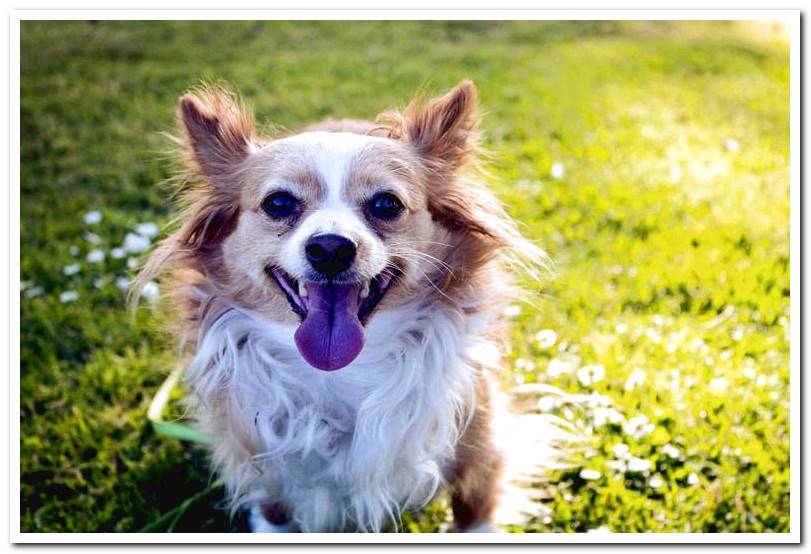Have you ever noticed that your dog has a dry and repetitive cough or makes some noises like he is choking? In small dog breeds this problem is very common and is related to the obstruction of its trachea.
Although the symptoms may be due to other conditions, such as kennel cough or choking, if these symptoms recur and increase over time, your puppy may experience tracheal collapse.
Index of contents
- 1 Trachea functionality
- 2 What is canine tracheal collapse?
- 2.1 Grades of disease
- 3 Tracheal Collapse Symptoms in a Dog
- 4 Diagnosis of tracheal collapse
- 5 Tracheal collapse prognosis
- 5.1 Additional care at home
Trachea functionality
The trachea is a partially flexible tube-shaped structure that connects and allows air to pass from the nose and mouth to the lungs. As the air enters and leaves, it moves fluidly through our dog’s windpipe, allowing it to breathe.
However, when the cartilaginous rings that allow it to have this mobility to the trachea become deformed, a tracheal collapse occurs, which prevents our dog from breathing in and breathing out normally.

What is canine tracheal collapse?
Tracheal collapse is defined as a chronic and degenerative disease that mainly suffer from small breed dogs, As the chihuahuapomeranian poodleyorkshire terrier and maltese bichon, among others.
The obstruction of the trachea due to the deformation or weakening of the cartilage found in this causes a narrowing of the space through which air circulates, hindering the breathing process.
Tracheal collapse can be congenital or acquired. In the second case, the condition generally appears associated with other chronic respiratory diseases, the Cushing’s disease and heart problems.
Grades of disease
Although from the first moment we notice symptoms we must show concern and tell our vet, depending on the phase or severity of the collapse, the disease can be divided into four degrees:
- Grade I: only a minor alteration in the trachea warns of a slight problem. The tracheal space can be reduced by 25%, but the tracheal cartilage rings still retain their shape.
- Grade II: the deformation of the rings is more noticeable, reaching a flattened shape given the thickening of the trachea muscle. Thus, the space through which air enters is reduced to 50%.
- Grade III: the tracheal muscle widens further, landing on the cartilage, flattening it almost completely. At this time, space has been reduced by up to 75%.
- Grade IV: the most serious degree occurs when the cartilage is totally deformed by the action and pressure of the thickened tracheal muscle. This causes a complete obstruction that prevents almost any air intake.

Tracheal Collapse Symptoms in a Dog
Tracheal collapse usually occurs in middle-aged or older dogs, being normally diagnosed from 6 or 7 years. However, it can also affect young dogs, which would indicate that it is a more serious condition.
Below, we present the symptoms that could alert us that our dog suffers from this disease, although we should not affirm or rule out any other before visiting our vet:
- Dry cough (Must be accompanied by other symptoms to associate with tracheal collapse)
- Sudden coughing fits that sound like a goose’s squawk
- Gasps
- Noises when breathing
- Dyspnea (breathlessness or shortness of breath)
- Sickness
- Exercise intolerance
- Fever
- Cyanosis (blue discoloration of the skin or paleness)
- Fainting
Although cough is one of the most common symptoms that can be associated with other diseases, dry cough of tracheal collapse usually appears first in times of strong emotions or stress, becoming constant when the condition worsens.
These symptoms should also not be confused with sporadic choking. In the event that the dog suffers from choking on any food or object and has serious problems with inhaling, we must remain calm and practice the Heimlich maneuver sooner.
Finally, it must be borne in mind that dogs that are overweight or obese or live in homes of smokers have higher risks of developing this problem or of aggravating their condition.

Diagnosis of tracheal collapse
To confirm that what our friend is suffering from is tracheal collapse, the vet will carry out a series of studies. The most common is to perform an x-ray, to assess the condition of the trachea and the respiratory system.
To complement this test, the veterinaryn can perform a fluoroscope analysis, to observe the state and behavior of the airways during inhalation and exhalation, or a tracheobronchoscopy, to determine the condition of the cartilage.
Tracheal collapse prognosis
After diagnosis by a veterinary professional, treatments will greatly improve the quality of life of our puppy. However, the disease is progressive and degenerative; there is no cure. Thus, the symptoms, despite decreasing, will become more noticeable and severe.
Depending on the grade, the vet will prescribe cough suppressants to calm the cough; bronchodilators, to facilitate breathing; expectorants, to expel secretions; antibiotics, for infections; and corticosteroids or sedatives, to calm anxiety and nervousness that worsen the situation.
In more severe cases (grade IV), surgery may be required, although not all dogs are suitable for this type of intervention. Surgery is aimed at the reconstruction of the tracheal form or to the placement of a prosthesis or implants that improve respiratory function.
Given the effort to breathe that some dogs with advanced disease have to do, it is common for other associated pathologies to appear, such as tracheitis, bronchitis, pulmonary hypertension and heart failure.
Additional care at home
Finally, in addition to veterinary care, your dog will require other care from you:
- Diets to
control your weight, especially if you are obese - Calm life, without changes that cause stress
- Harnessed walks, never with collars that press on your throat
- Avoid sudden exercises
- Smoke and pollutant free environments
- Vaccines a day, to avoid diseases like canine cough
- Beware of sudden temperatures that alter your health.
